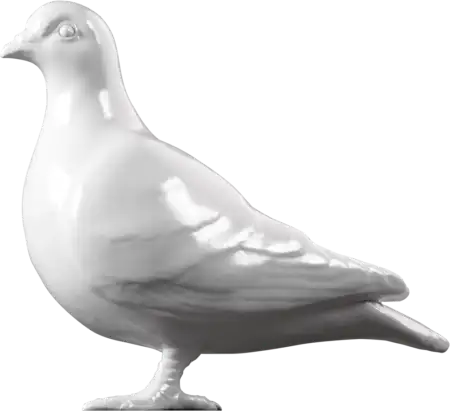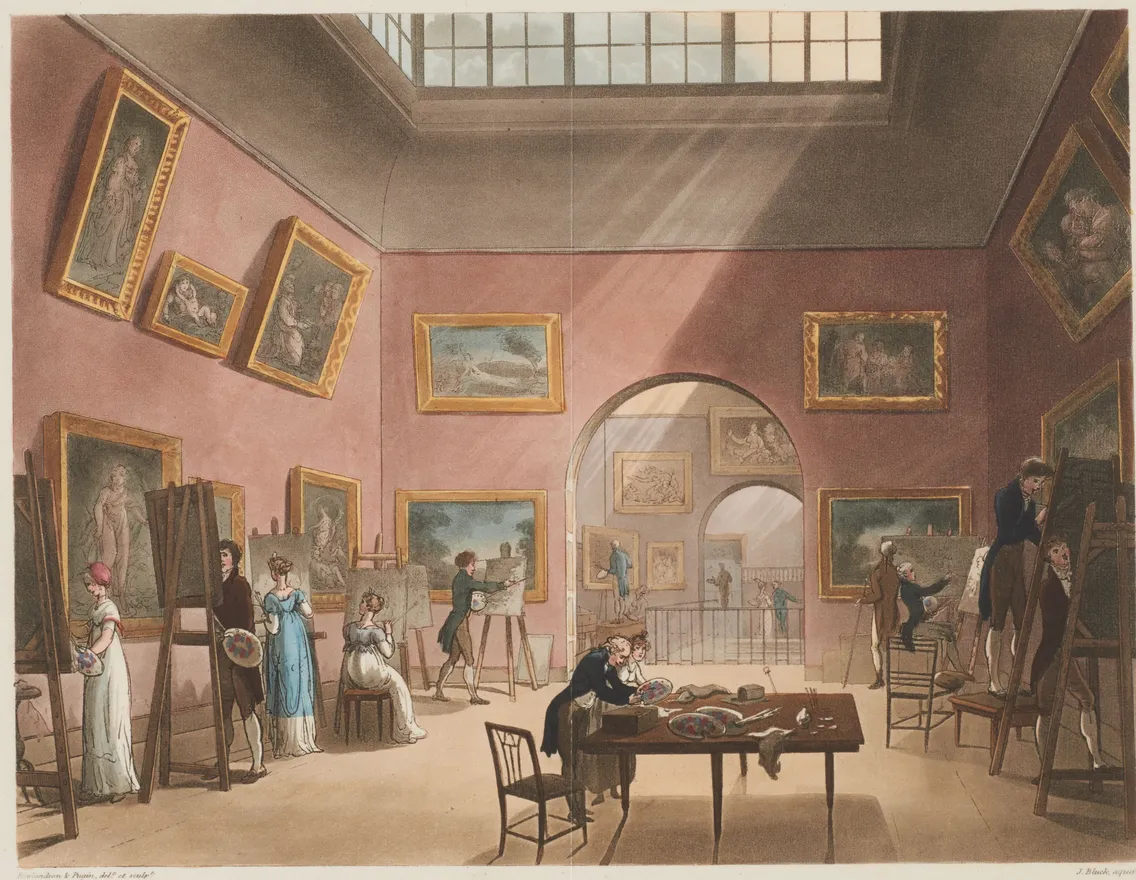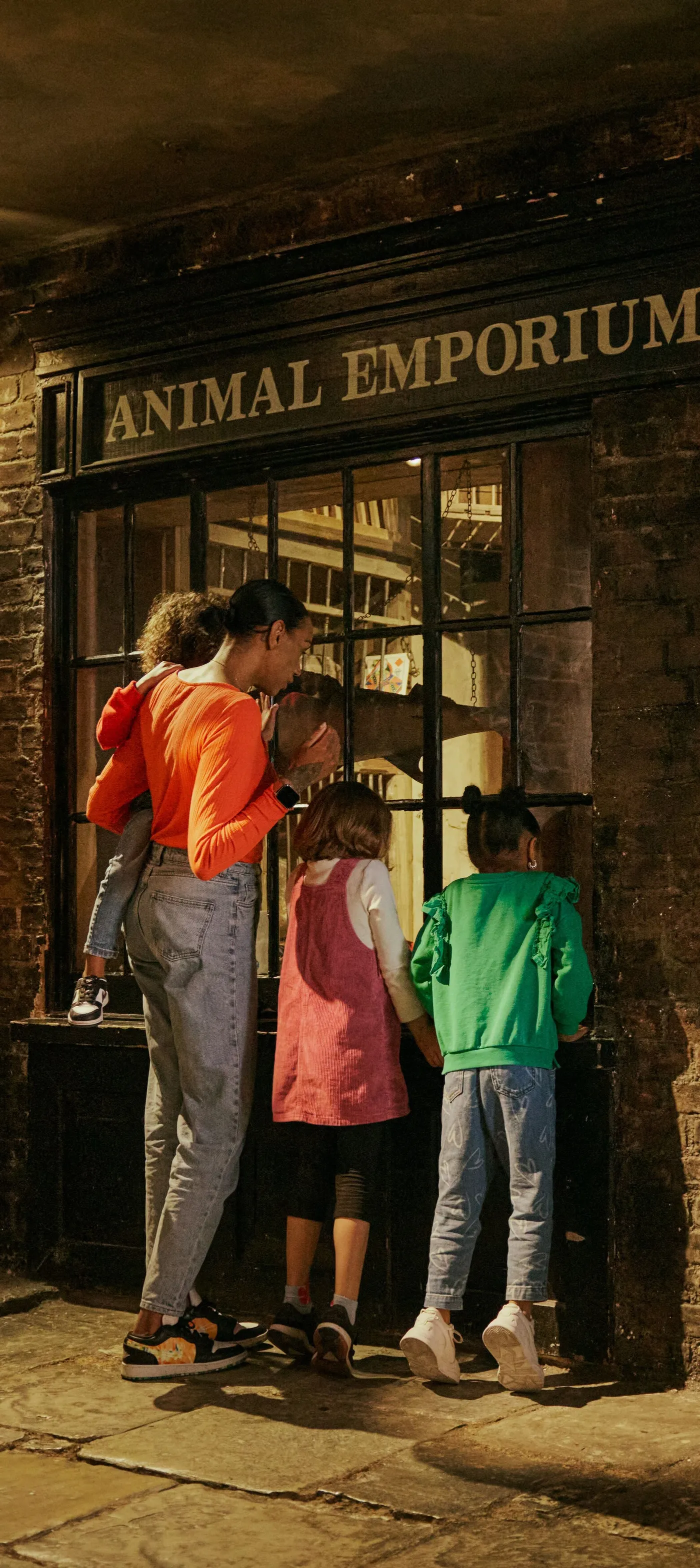24 March 2017 — By Sally Brooks, Alwyn Collinson
From royal menagerie to murderous gardener: A holiday in Georgian London
Dive into the second part of Elizabeth Chivers’ fascinating diary from spring 1814. From ghostly legends and a murderous gardener to Hyde Park’s nobility and Polito’s menagerie, her journey captures Georgian London’s allure.
In spring 1814, Elizabeth Chivers went on a family trip from Bath to London, visiting dozens of attractions in the capital with her sister Sarah and their uncle. The first part covered the first six days. Here we continue onwards from Day 7 with edited extracts from her diary (now in the London Museum Library) illustrated with images of London from our collections.
Day 6: Scratching Fanny & murderous gardeners (Saturday 19 March 1814)

A Bird's-Eye View of Smithfield Market, 1811. Coloured aquatint from Rudolph Ackermann's original.
Our sixth day’s march we began with leaving our Hotel at eleven we passed by Free Masons Hall, Middle Row Holborn, St. Andrews church, Cock Lane famous for the Ghost supposed to have been seen in it some years ago...
[Otherwise known as Scratching Fanny. It was a hoax created for the mundane purposes of money. Richard Parsons tried to frame William Kent (to whom he owed money) for the ‘murder’ of his wife Fanny. The scratching noises were found to be created by Parsons’s daughter Betty.]
[We] saw Smithfield Market, Bartholomews Hospital a most noble building, Blue coat School and Hospital. We called on Mr Dawes, saw the city of London and London Taverns, over London Bridge by King’s Bench prison to the Elephant and Castle Newington. We here took a coach to Kensington Turnpike where we were glad to alight from our vehicle as we found walking so far preferable. We were astonished at the vast number of very elegant houses we passed which were chiefly inhabited by merchants and those who have acquired large fortunes in town.

View of Lambeth Palace, 1833. Watercolour by HW Burgess.
We saw a very pretty house which my Uncle lived in about twenty years ago. A little further brought us to Mrs Willson’s on Clapham common an old and valued friend of my Uncles who we felt great pleasure in being introduced to. We spent half an hour very pleasantly with her then proceeded on the common to take a view of a noble mansion which my Uncle resided in. It commands a beautiful prospect of the common which is very extensive. It is surrounded with handsome houses, and interspersed with wood and water, and roads which are like gravel walks cross it in different directions. In Summer it must be extremely beautiful. A more charming situation I think cannot be found in the Kingdom, within a delightful ride or walk to town, yet as much the country as if twenty miles from it.
[Great Uncle, William Chivers, had been murdered in his garden at Battersea Rise, by his gardener William Duncan, on 24 January 1807. William Duncan hit Chivers with a spade and on being found guilty of murder was transported to Australia.]
Our late Uncle’s residence and the house next to it now appeared to our view, which has a beautiful effect…
Day 7: A Sunday in Hyde Park & the Asylum (Sunday 20 March 1814)

The Dress Carriage of Viscount Eversley in Hyde Park, 1856, an oil painting by Edwin Frederick Holt.
On our seventh morning we left the Rainbow at half past ten. We set of to attend the Asylum [Royal Asylum for Female Orphans, Westminster Bridge Road, Lambeth] it being Sunday in our way we took a peep into the King’s Mews and saw some of the royal horses. We next came to Spring Gardens to the Royal Parade horse guards where we saw the troop march off in high order which was a fine sight and the band played most beautifully.
At eleven we entered the Asylum. This most excellent institution is for two hundred poor female Orphans who are educated clothed and supported until they are at an age fit for service. The chapel was so crowded it was with great difficulty we procured seats, at the top of it around the Organ sat the Children all dressed exactly alike and particularly neat which was a very fine and affecting sight. The clergyman delivered a most excellent and impressive sermon, which drew tears from many of his congregation, alluding to this great charity and which I think would induce numbers to contribute to its support. In his excellent discourse he introduced the death of Lord Lyttleton who had a wonderful reassessing of his disolution but yet was not prepared for that aweful event.
[Thomas Lyttelton, second Baron Lyttelton (1744-1779?) whose dissolute lifestyle included gambling debts, duels, absconding to Paris with a barmaid, and a spell in prison in Paris after a contretemps in a brothel.]
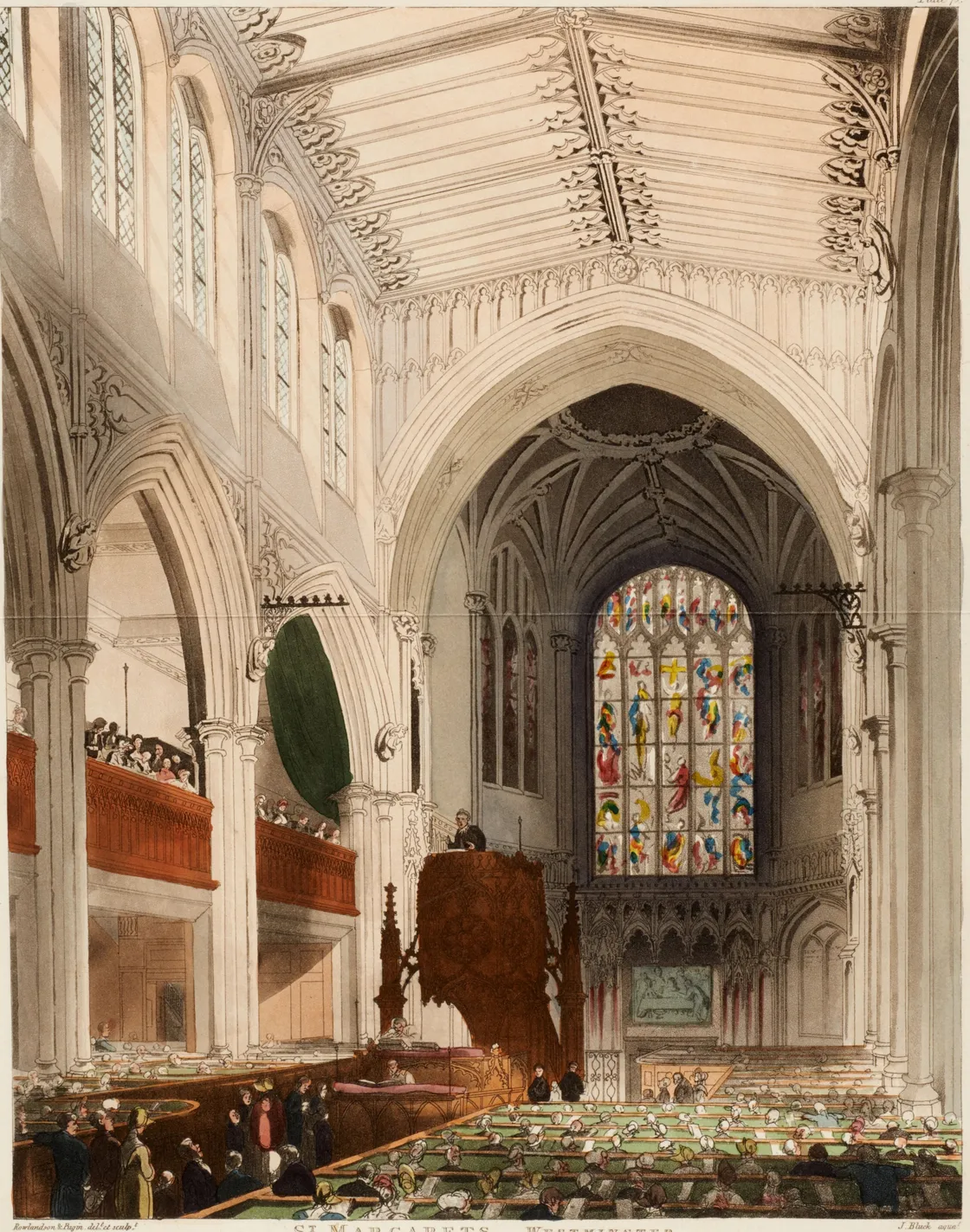
St Margaret's, Westminster, 1809, published in Microcosm of London, as a typical view of a service in a London church.
My Uncle and Father attended his remains to their last home at Hagley in Worcestershire about thirty years ago. We were highly gratified with our visit to the Asylum the fund of which we were sorry to find is in need of the assistance of the charitable and affluent. From it we proceeded to great George Street Westminster having stopped at a pastry cooks by the way and eat a very nice tartlet.
We walked thro the Bird Cage walk St James’s park passed the Queen’s palace and Green park to Hyde park corner and then into Hyde park where we were not a little astonished at the vast number of elegant carriages many of them the first noblemens grand equipage driving backwards and forwards in this beautiful park. We saw the princess Charlotte’s carriage also the Lord Mayor’s superb coach. We returned home thro Piccadilly which from the Hay market to Hyde park corner is about a mile and a half long.
…
Day 12: Elephant, rhinoceros and camel, oh my! (Friday 25 March 1814)

Royal Menagerie, Exeter Change, 1813. This engraving by Samuel Howitt depicts animals on display.
Soon after breakfast on our twelfth morning we once more set off to see a little more of this wonderful place. We went down Cheapside and on to Bonds Change Alley [bankers John Bond & son] where we were a very long time detained. We next bent our course to Mr Alderman Birches where we ate a little of his delightful pastry then proceeded to Exeter Change in the Strand to see the finest collection of wild Beasts in the Kingdom, which is kept and managed by Polito [Polito's Royal Menagerie].
The great variety of animals we here saw quite astonished us, there is an Elephant, Rhinoceros and camel, a Lyon and a number of most beautiful Leopards, several Tygers, Baboon, and Monkeys and a vast many more too numerous for me to notice. In another apartment we saw a collection of most beautiful birds natives of many different countries.
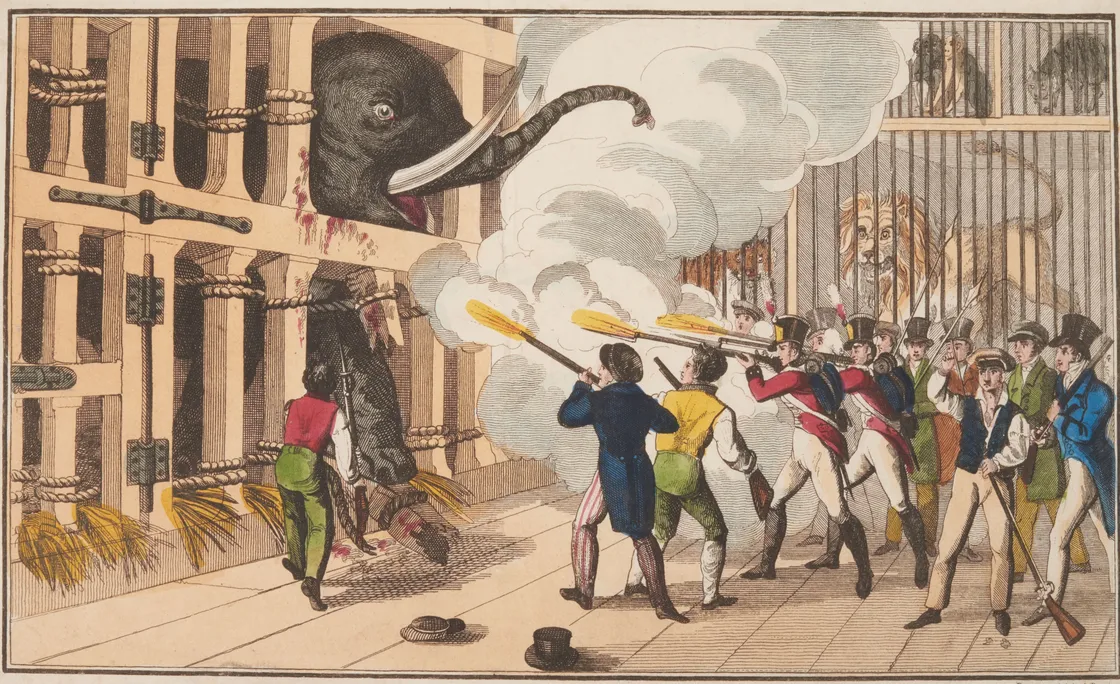
The Destruction of the Elephant at Exeter 'Change', 1826. This unfortunate incident occurred about 12 years after Elizabeth's visit. Chunee the elephant became aggressive after being confined in a small cage, and soldiers were called into shoot him.
We were next shewn into a Room filled with a wonderful assortment of curiosities, the principle was Mrs Phillips Shell work in which was formed grottos, Temples, flowers etc. which had a very pretty effect. There were many other curious things which was brought from …… Museum. We departed from Exeter Change highly pleased with our visit to it.
We returned to our Hotel about four to prepare for company who we expected to dinner at half past five arrived Captn. Willm. Chivers and his Lady a very cheerful pleasant woman and he a very agreeable man. We enjoy’d their company until ten O’clock at which hour they took their leave.
Day 13: Touring the Tower (Saturday 26 March 1814)
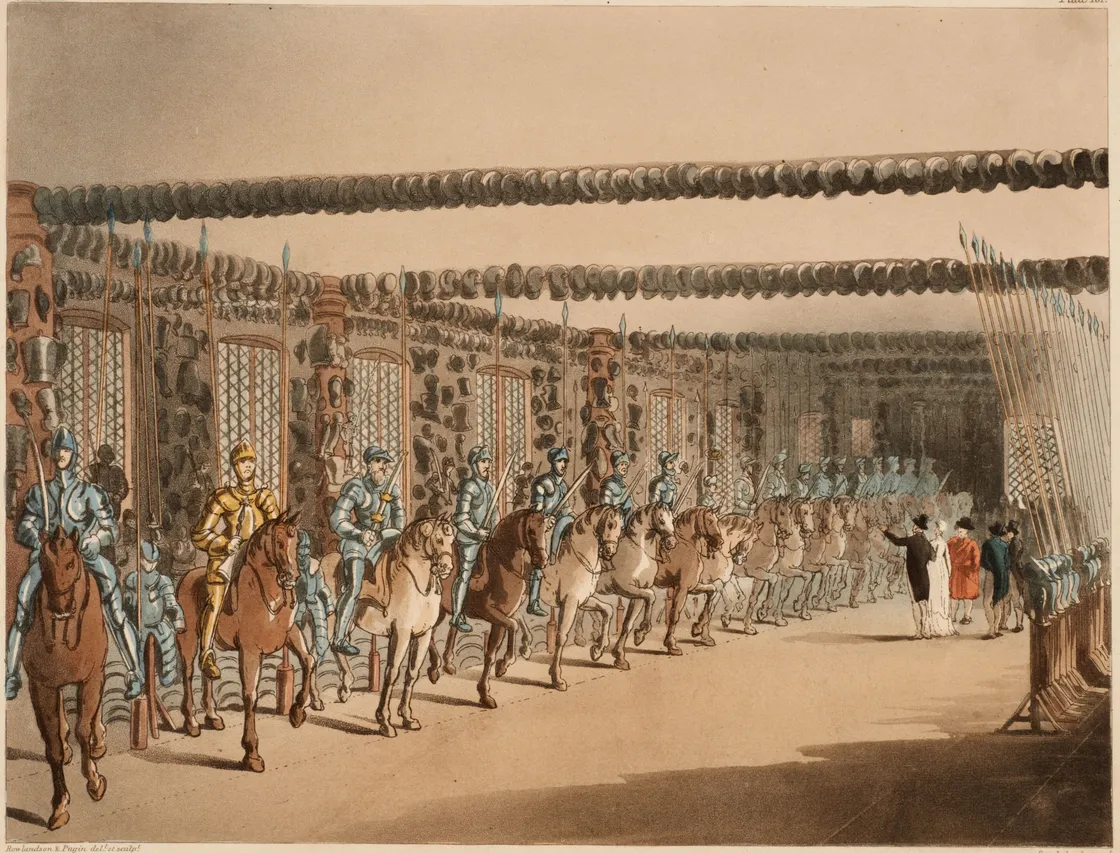
Horse Armoury at the Tower of London, 1809. A coloured aquatint by Rudolph Ackermann.
We left the Rainbow soon after ten on our Thirteenth morning. We bent our course to Mr Thornhills Judd St. Brunswick square, we passed St Georges fine church Bloomsbury which has a singular spire on the top of it is a noble statue of one of the Kings. We next took a view of the exterior of the British Museum an immense building in great Russel street and then into Russel Square in it there is a fine Bronze Statue of the late Duke of Bedford on whose property this noble Square was built.
We next arrived at Mr Thornhills with whom we sat about half an hour and then along with Mr Thornhill and his daughter we stepped into a coach and drove to Messrs Bonds where my Uncle put her into possession of the jewls and plate the property of her Uncle the late Revd. Tho. Chivers. Here we parted with them and next proceeded to the Tower in our way we pass’d my Father’s old Wine Vaults in Crutched Fryers and over Tower Hill on which ground many unfortunate noblemen were beheaded in the time of the Rebellion.

View of the Tower of London from the Thames, 1819. A watercolour by John Gendall.
We now arrived at the Tower and attended by one of the Yeomen proceeded to view the Armoury, which is a most grand and beautiful sight, the great variety of arms antient and modern, the very beautiful manner in which the small Armoury is arranged indeed it is quite impossible for me to describe the order and wonderful regularity in which they are placed in a magnificent room 345 feet in length…
We departed from the Tower much pleased and very much astonished with what we had seen. We proceeded thro Mark Lane, where the corn market is held by Ironmongers Hall, to Birches then to Mr Dawes’s and from thence took a view of the Stock Exchange and also had a peep at the Swan and two necks in Lud lane, a charming Inn, in a delightful open airy situation not in the least annoy’d by the noise of stage coaches and waggons Ironically speaking. We pass’d thro Hatton garden saw what was the Pewter plater [?] Lodge. We got home to dine at four, and in the evening reading writing and backgammon.
Read the third and final illustrated extract from Elizabeth Chivers' diary.
Sally Brooks is Librarian and Alwyn Collinson is Digital Editor at London Museum.
